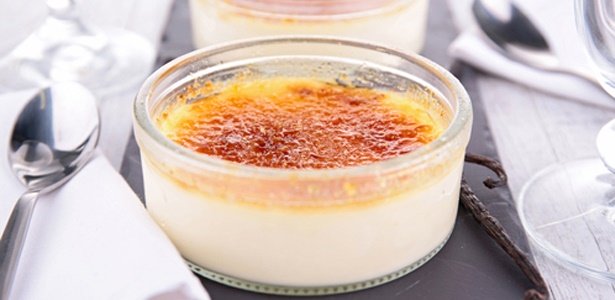Crème brûlée is super easy to cook and makes you look like a dinner party rock star because you can prepare them well in advance and just do the flame thrower bit for a party trick!
Versatile flavourings
The most common flavouring for crème brûlée is vanilla. The flavour is added by infusing the cream with the desired flavourant – so in the case of vanilla, slice the vanilla pod in half and scrape out the seeds then add the seeds and the pod to the cream while it is heating and allow to infuse. Strain out the pod before mixing with the egg yolks, leaving behind the gorgeous vanilla seed flecks.
In place of vanilla pods, substitute ginger and lemongrass (finely sliced), grated zest of lemon or orange, coarsely ground coffee beans. The list is virtually endless! Or used 5ml of your favourite essence or extract.
In order to maximise the flavour infusion, place the cream on a low heat and bring it slowly up to the boil. This will give the chosen ingredient maximum time to impart its unique flavour to the cream. Also watch out for over-boiling the cream, it can happen in an instant and there isn’t much that is harder to clean up.
What to do with whites
Egg whites freeze remarkably well. Place left-over egg whites in a plastic container and freeze for up to 3 months. Defrost a day before needed, as defrosting in the microwave leads to a horrible eggy mess (trust me on this one). Egg whites can be used to make meringue, macarons, royal icing, marshmallow icing, egg white omelettes and pavlovas.
Beating the yolks (or not)
When the sugar is added to the egg yolks mix it lightly with a wooden spoon to prevent too many bubbles forming. If the yolks become foamy at this stage they will form a foam crust on the top of the finished product, which can interfere with the caramel brûlée bit.
Bain Marie baking
Some recipes call for the custard to be cooked on top of the stove for a bit before placing it in the ramekins and baking in a water bath inside the oven. Personally, I would skip that step as it just adds to the time and number of dishes to wash, and it is unnecessary for the final product, just remember to adjust your cooking time accordingly.
The word ‘Bain Marie’ may refer to a double boiler (to be used on top of the stove) or a water bath (tray filled with water in which the ramekins are placed). In both cases the warm water acts as an insulation, preventing the eggs from getting too hot and turning to scramble.
Ramekins and serving dishes
When choosing a ramekin or dish to bake the custard in, make sure that it is oven-proof before you begin, and preferably ceramic or Pyrex glass. Most recipes can be baked as one large custard or in individual portions, but follow the recipe guidelines for the sizes that you are planning on baking and if you plan to deviate from the recipe adjust the cooking time accordingly. One large custard will take longer to bake than small ramekins. Test if you custard is done by shaking the tray, if the custard is set (ie not sloshy) in the middle, but still wobbly then it is perfectly done. Remove it from the oven and leave it to cool in the hot water of the Bain Marie. If it no longer has wobble, remove it from the hot water as soon as possible to cool quicker and prevent it from cooking further.
Chilling
Once cool, place in the fridge to cool completely (preferably overnight). If the custard is nice and cold before flaming there is less chance of overcooking the eggs. Cooked cooled custards can keep in the fridge for up to 3 days.
Flaming
Now for the fun part! The word brûlée means to burn, so don’t be afraid to get a bit of blackened sugar. There are quite a few methods to achieve this:
1. The flame thrower (available from equipment supply stores) – sprinkle sugar (most commonly castor sugar, but you could use brown sugar or granulated sugar) over the whole top of the chilled custard and melt it using the flame, turning and shaking the ramekin as you go to get even coverage.
2. The grill on your oven – place the chilled ramekins in a tray filled with ice water and pre-heat your grill to its maximum temperature. Place the oven rack at the highest point in the oven (where you can still get your tray in) so your custards are as close to the heat as possible. Sprinkle each with sugar (castor, brown or granulated) and place the tray under the hot grill, leaving the oven door open to allow air to circulate. Check to see if the sugar is melted after a few minutes and move the ramekins around as needed (grills are seldom even).
3. Melting the sugar separately and pouring it over the top of the custard – place granulated sugar in a non-stick pan and place it over a medium heat. Shake or stir the pan occasionally until the sugar begins to melt. Keep a close eye on it as it can burn very quickly. Once the sugar has completely melted and is starting to turn a golden colour, pour the caramel over the top of each ramekin.
Looking for the recipe? Click here.
Follow Julie Donald on Twitter @askjuliedonald

